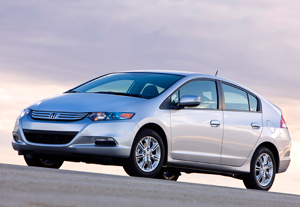
The end of the internal combustion engine is not near.
But a new study foresees a powertrain revolution starting this year, triggered in large measure by pollution concerns and carbon-dioxide caps, having a far-reaching impact on the future shape of the global automotive industry.
The 40-page report by The Goldman Sachs Group concludes that “2010 marks the beginning of the mixed-powertrain era, where hybrid-electric vehicles, plug-in hybrid (electric) vehicles, electric vehicles and conventional gasoline/diesel engines will coexist.”
The study estimates sales of HEVs and PHEVs will rise to14 million units in 2020, 13% of the global automotive market. EV sales will reach 1.7 million units then, or 2% of the market.
Some 98% of vehicles sold that year still will utilize an IC engine, and the report emphasizes the need to improve the fuel efficiency of existing gasoline and diesel engines, suggesting a 30% reduction in CO2 emissions is possible.
At the same time, however, the report warns “early preparation for the mixed-powertrain era will be crucial to survival in the auto industry.”
The formation of multi-company alliances to share the risks and rewards of HEV, PHEV and EV development are likely to accelerate, it concludes. In the last five years, there have been more than a dozen tie-ups of one kind or another between global auto makers and with suppliers.
“Global regulations on CO2 emissions are ushering in the powertrain revolution,” say the study’s authors, noting the transportation industry is responsible for 20%-30% of worldwide CO2 production.

They expect caps on CO2 emissions to be lowered further in three major markets. The informal goal for 2020 is 167 g/km in the U.S. (vs. 198 g/km currently) and 140 g/km in Japan (vs. 181 g/km today).
The European target for that year of 95 g/km, compared with 140 g/km currently, “looks very hard to achieve,” the report says.
How hard? Consider the gap between average European CO2 emissions by maker in 2008 and the 2020 target.
Fiat Automobiles SpA led the industry with the lowest emissions in 2008, 138 g/km. PSA Peugeot Citroen was a close second with 139 g/km.
Renault SA and Toyota Motor Corp. followed at 147 g/km, trailed by Hyundai Motor Co. Ltd. (149), Ford Motor Co. (152), General Motors Co. (153), BMW AG (154), Honda Motor Co. Ltd. (154), Suzuki Motor Corp. (156), Volkswagen AG (159), Nissan Motor Co. Ltd. (161) and Daimler AG (175).
By comparison, CO2 emissions from HEVs are only half that of conventional powerplants, and EVs produce zero CO2 directly.
The report “expects the proportion of eco-friendly vehicles to surge in the run-up to 2020, reaching 45% in Japan, 38% in the U.S. and 20% in Western Europe.” A 12% penetration is predicted for China, emphasizing the need for auto makers to have a hybrid and electric-vehicle sales strategy for emerging markets.
Developing successful new strategies is rarely, if ever, quick or easy.
For almost seven years following the launch of Toyota’s first-generation Prius in 1997, annual global sales were small and growth negligible. The second-generation Prius, launched in September 2003 with improved fuel economy, did much better as crude oil prices rose sharply. In 2008, sales reached 285,700 units.
After the launch of the third-generation Prius in May 2009, with fuel efficiency increasing further, sales continued to rise sharply, hitting 404,200 units that year, helped by incentive programs in several countries. Deliveries totaled 270,200 units in first-half 2010.
Yet profits proved elusive. “Over a decade has passed since Toyota launched hybrids, but we think the hybrid business is only now turning profitable,” the Goldman Sachs study says.
Even so, aggressive deployment of hybrids by Toyota, Honda, Nissan, Ford and GM is predicted.
Conversely, the report emphasizes EVs, first launched in Japan last year by Mitsubishi Motors Corp. and Fuji Heavy Industries Ltd., face three major hurdles – a shorter cruising range than hybrids, a need for charging stations and the durability of lithium-ion batteries.
Among conclusions:
- bEVs now are at a stage similar to that of hybrids in 1997. For the next few years, the main objective of producers will be accumulating data on performance and the durability of batteries and motors. It will be five to 10 years before meaningful market penetration begins, after cruising distances have improved to at least 250 miles (400 km) per charge.
- Although Nissan is a leader in EVs, it will take five to 10 years before the Leaf contributes to company earnings.
- Because batteries account for at least half of EV costs, a reduction in their cost is critical. The GSG report anticipates the price of Li-ion batteries will drop 40%-50% over the next five years as production volume expands.
- The main obstacle to EV penetration is the development of a battery-charging infrastructure.
Experiments in 2006 by Tokyo Electric Power indicate one fast-charging facility, costing about ¥3 million ($33,000) and serving a 3-mile (5-km) radius, would eliminate driver worry about running out of power.
According to Goldman Sachs calculations, constructing 84 facilities and installing two fast-chargers in each, would cover the Tokyo area at a cost of about ¥1 billion ($11.1 million), and government financing probably would be the most practical way to underwrite the cost of this infrastructure.
As the race for hybrid and electric-vehicle sales heats up, there inevitably will be also-rans, but the authors of the Goldman Sachs report see three Japanese auto makers “taking steps to cement their place in the winner’s circle.
“Toyota is far ahead of rivals in amassing technologies needed for multiple powertrain categories, and we think its lead will become much more evident as the industry moves further into the mixed powertrain era.”
The authors say Honda’s hybrid strategy is rapidly catching up with Toyota’s in terms of volumes and costs. The Renault-Nissan Alliance trails in hybrids “but is ahead of rivals in building up a global expansion strategy for mass-produced electric vehicles.”



